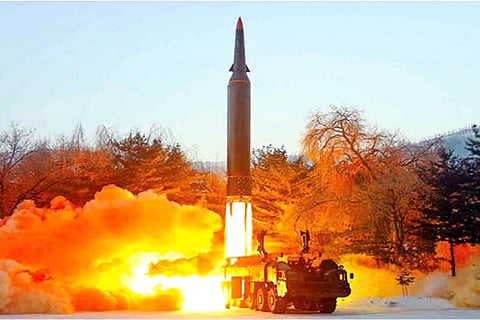

North Korea began the year by testing what Pyongyang claims is a new type of “hypersonic missile,” in the country’s first weapons test since autumn 2021. As the reclusive East Asian nation continues developing high-tech weapons systems, some tests over the past months have shown potentially big steps. Others, meanwhile, have looked like adaptations of previously available technology. A cause for concern has been the North’s development of hypersonic glide vehicles (HGVs), an advanced weapons system being developed by major militaries around the world. HGVs involve a projectile launched on a rocket booster with a velocity at least five times the speed of sound, featuring increased manoeuvrability that can evade detection and interception. While most ballistic missiles can already fly at hypersonic speeds, analysts have said the HGV’s ability to fly at low altitudes and manoeuvre in-flight make them a greater threat. According to Jeffrey Lewis, an arms expert at the Middlebury Institute of International Studies in the US, the type of HGV launched this week looks to be a type of conical hypersonic glider, also known as a “manoeuvring reentry vehicle (MaRV).”
The weapons system tested this week flew a total 700 kilometers (435 miles), including a lateral manoeuvre that took it some 120 kilometers. However, MaRV is not a novel type of weapon, and North Korea has tested similar vehicles before on less-powerful boosters, such as the 2017 launch of a MaRV on a short-range Scud missile. The missile fired this week appears to have first been shown off at the “Self-Defense-2021” expo in Pyongyang in October 2021, according to Ankit Panda, a senior fellow with the nuclear policy program at the Carnegie Endowment for International Peace.
In late September, North Korea surprised the world by announcing for the first time that it had tested an HGV. State media said the missile system was called Hwasong-8, Hwasong, being the name North Korea gives to a series of missiles that translates to Mars in English. According to a photograph of the September launch analyzed by 38 North, Washington-based think tank that monitors North Korea, an “arrowhead-shaped vehicle with stubby wings resembling a hypersonic glide vehicle” was atop an intermediate-range ballistic missile (IRBM), a booster resembling a shortened version of a Hwasong-12 ballistic missile. The shape of the hypersonic glider launched in September appeared wedge-shaped, different than the conical-shaped glider launched this past week. The missile boosters used in the launches reportedly used more mobile type of preloaded storable liquid propellant called a missile fuel ampoule.
North Korea is banned by international sanctions from testing ballistic missiles and nuclear weapons. Nevertheless, the Kim Jong Un-led regime in Pyongyang has pushed ahead with weapons tests, arguing it has a right to self-defense and that diplomacy with its adversaries can only be conducted from a position of military strength.
“Given the hardships North Korea is facing at the moment, there are likely calculations about what kinds of weapons testing can be done without galvanizing the international community against it,” said Jenny Town of 38 North. Town added that, unlike in 2017, the North is now more likely to tread lightly with its weapons testing.”Pyongyang seemed to be willing to sacrifice its foreign relations at that time to achieve a certain level of success, but these days, with a real focus on economic development as part of its national strategy and an urgent need to forge a path to economic recovery in the near term, some level of foreign relations and support is necessary,” she said.
This article was provided by Deutsche Welle
Visit news.dtnext.in to explore our interactive epaper!
Download the DT Next app for more exciting features!
Click here for iOS
Click here for Android